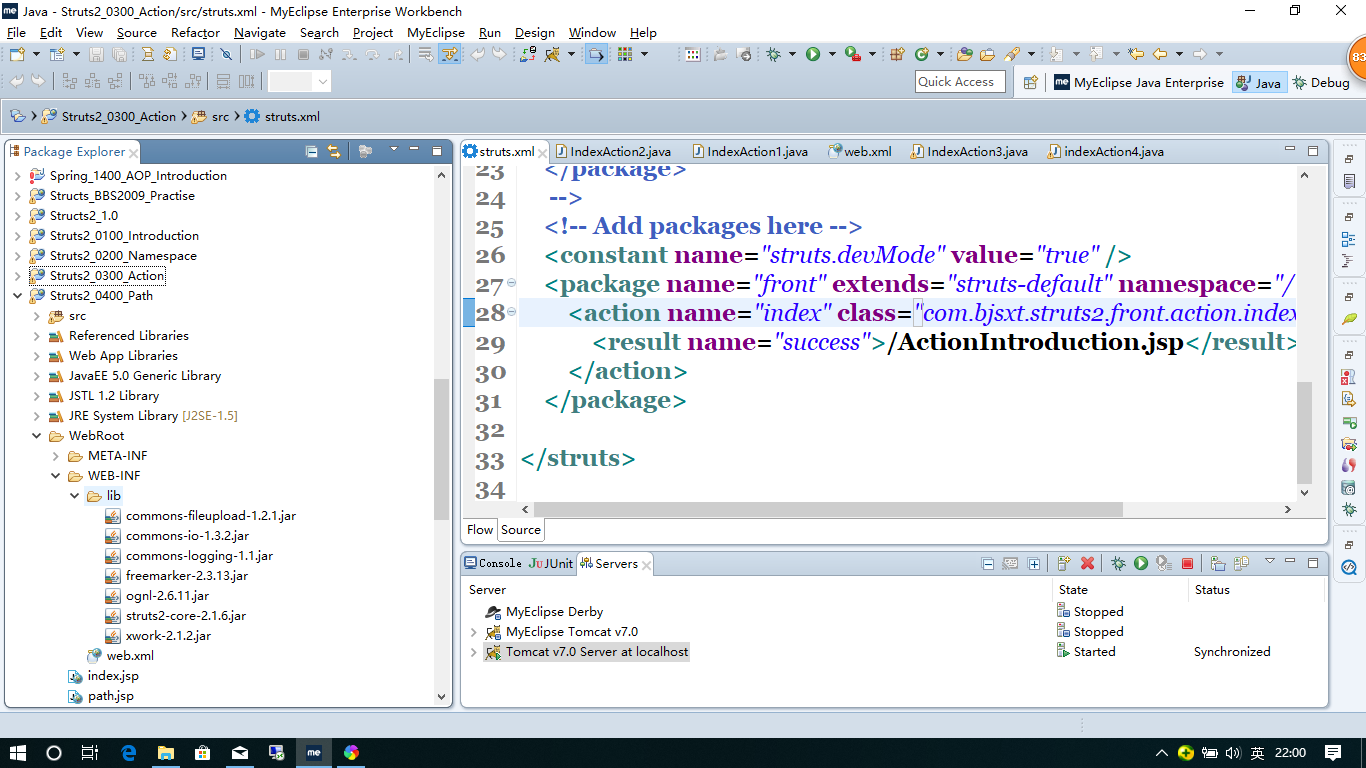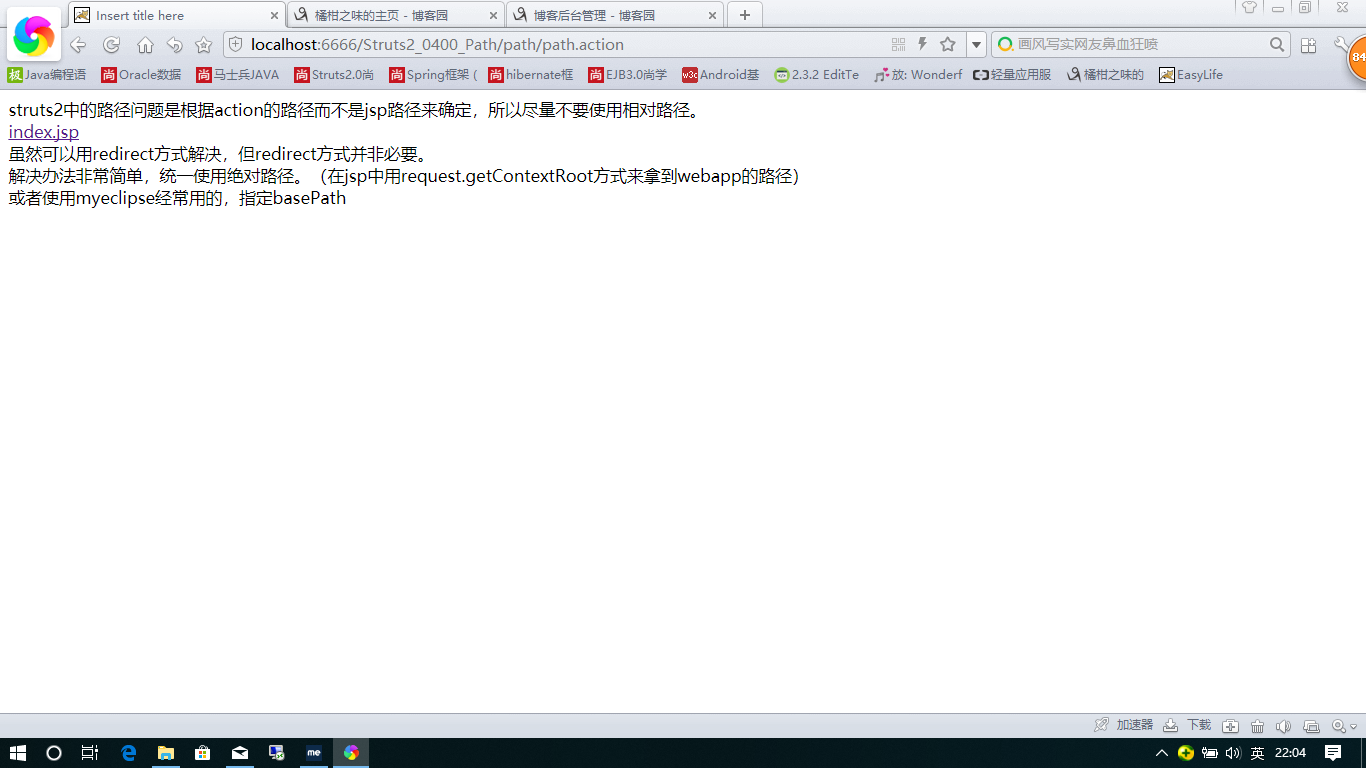Structs复习 Path问题
Path问题相对复杂 主要是路劲问题 但结论很简单 就是统一使用绝对路径
jar包

web.xml
<?xml version="1.0" encoding="UTF-8"?> <web-app version="2.5" xmlns="http://java.sun.com/xml/ns/javaee" xmlns:xsi="http://www.w3.org/2001/XMLSchema-instance" xsi:schemaLocation="http://java.sun.com/xml/ns/javaee http://java.sun.com/xml/ns/javaee/web-app_2_5.xsd"> <welcome-file-list> <welcome-file>index.jsp</welcome-file> </welcome-file-list> <filter> <filter-name>struts2</filter-name> <filter-class>org.apache.struts2.dispatcher.ng.filter.StrutsPrepareAndExecuteFilter</filter-class> </filter> <filter-mapping> <filter-name>struts2</filter-name> <url-pattern>/*</url-pattern> </filter-mapping> </web-app>
Structs.xml
<?xml version="1.0" encoding="UTF-8" ?> <!DOCTYPE struts PUBLIC "-//Apache Software Foundation//DTD Struts Configuration 2.0//EN" "http://struts.apache.org/dtds/struts-2.0.dtd"> <struts> <constant name="struts.devMode" value="true" /> <package name="path" extends="struts-default" namespace="/path"> <action name="path" class="com.bjsxt.struts2.path.action.PathAction"> <result name="path">/path.jsp</result> </action> </package> </struts>
PathAction.java
package com.bjsxt.struts2.path.action; public class PathAction { public String execute() { return "path"; } }
Path.jsp
<?xml version="1.0" encoding="GB18030" ?> <%@ page language="java" contentType="text/html; charset=GB18030" pageEncoding="GB18030"%> <%@taglib uri="/struts-tags" prefix="s" %> <% String path = request.getContextPath(); String basePath = request.getScheme()+"://"+request.getServerName()+":"+request.getServerPort()+path+"/"; %> <!DOCTYPE html PUBLIC "-//W3C//DTD XHTML 1.0 Transitional//EN" "http://www.w3.org/TR/xhtml1/DTD/xhtml1-transitional.dtd"> <html xmlns="http://www.w3.org/1999/xhtml"> <head> <base href="<%=basePath%>" /> <meta http-equiv="Content-Type" content="text/html; charset=GB18030" /> <title>Insert title here</title> </head> <body> struts2中的路径问题是根据action的路径而不是jsp路径来确定,所以尽量不要使用相对路径。<br /> <a href="index.jsp">index.jsp</a> <br /> 虽然可以用redirect方式解决,但redirect方式并非必要。 <br /> 解决办法非常简单,统一使用绝对路径。(在jsp中用request.getContextRoot方式来拿到webapp的路径) <br /> 或者使用myeclipse经常用的,指定basePath </body> </html>
index.jso
<?xml version="1.0" encoding="GB18030" ?> <%@ page language="java" contentType="text/html; charset=GB18030" pageEncoding="GB18030"%> <%@taglib uri="/struts-tags" prefix="s" %> <% String path = request.getContextPath(); String basePath = request.getScheme()+"://"+request.getServerName()+":"+request.getServerPort()+path+"/"; %> <!DOCTYPE html PUBLIC "-//W3C//DTD XHTML 1.0 Transitional//EN" "http://www.w3.org/TR/xhtml1/DTD/xhtml1-transitional.dtd"> <html xmlns="http://www.w3.org/1999/xhtml"> <head> <base href="<%=basePath%>" /> <meta http-equiv="Content-Type" content="text/html; charset=GB18030" /> <title>Insert title here</title> </head> <body> struts2中的路径问题是根据action的路径而不是jsp路径来确定,所以尽量不要使用相对路径。<br /> <a href="index.jsp">index.jsp</a> <br /> 虽然可以用redirect方式解决,但redirect方式并非必要。 <br /> 解决办法非常简单,统一使用绝对路径。(在jsp中用request.getContextRoot方式来拿到webapp的路径) <br /> 或者使用myeclipse经常用的,指定basePath </body> </html>
输入
http://localhost:6666/Struts2_0400_Path/index.jsp




